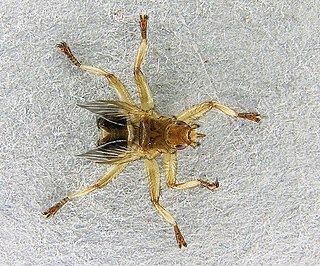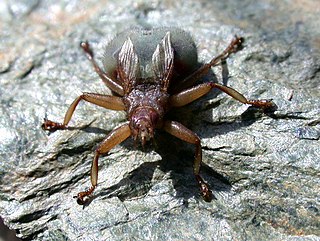
Calyptratae is a subsection of Schizophora in the insect order Diptera, commonly referred to as the calyptrate muscoids. It consists of those flies which possess a calypter that covers the halteres, among which are some of the most familiar of all flies, such as the house fly.

Hippoboscoidea is a superfamily of the Calyptratae. The flies in this superfamily are blood-feeding obligate parasites of their hosts. Four families are often placed here:
Adenotrophic viviparity means "gland fed, live birth". This is the reproductive mode of insects such as tsetse flies (Glossinidae), keds (Hippoboscidae) and bat flies, as adenotrophic viviparity is a characteristic feature of the superfamily Hippoboscoidea. It has also been observed in members of the subfamily Mesembrinellinae.

Hippoboscidae, the louse flies or keds, are obligate parasites of mammals and birds. In this family, the winged species can fly at least reasonably well, though others with vestigial or no wings are flightless and highly apomorphic. As usual in their superfamily Hippoboscoidea, most of the larval development takes place within the mother's body, and pupation occurs almost immediately.

The Streblidae are a family of flies in the superfamily Hippoboscoidea, and together with their relatives the Nycteribiidae, are known as bat flies. They are winged or wingless ectoparasites of bats, and often have long legs. They appear to be host-specific, with different species of bat flies occurring only on particular species of bat hosts, sometimes with multiple species of flies sharing a host bat.

The dwarf dog-faced bat is a species of free-tailed bat from South America. It is found in Argentina, Bolivia, Brazil, Colombia, Ecuador, Guyana, Peru, Paraguay and Uruguay, typically at lower elevations. It is one of two species in the genus Molossops, the other being the rufous dog-faced bat. Three subspecies are often recognized, though mammalogist Judith Eger considers it monotypic with no subspecies. It is a small free-tailed bat, with a forearm length of 28.9–32.5 mm (1.14–1.28 in) and a weight of 5–8 g (0.18–0.28 oz); males are larger than females. It is brown, with paler belly fur and darker back fur. Its wings are unusual for a free-tailed bat, with exceptionally broad wingtips. Additionally, it has low wing loading, meaning that it has a large wing surface area relative to its body weight. Therefore, it flies more similarly to a vesper bat than to other species in its own family. As it forages at night for its insect prey, including moths, beetles, and others, it uses two kinds of frequency-modulated echolocation calls: one type is to navigate in open areas and to search for prey, while the other type is used for navigating in cluttered areas or while approaching a prey item.
Dormer's bat or Dormer's pipistrelle is a species of vesper bat. It is the only species in its genus. It is found in Bangladesh, Bhutan, India, and Pakistan. Its natural habitats are subtropical and tropical dry forests, arable land, plantations, rural gardens, and urban areas.

The lesser bamboo bat or lesser flat-headed bat is one of the smallest species of vesper bat, and is native to Southeast Asia.

The Egyptian tomb bat is a species of sac-winged bat in the family Emballonuridae. It is a medium- to large-sized microbat with a mass of approximately 30 g (1.1 oz). It is an aerial insectivore, foraging in open space. Based on individuals captured in Ethiopia, it is thought to feed predominantly on Lepidoptera, but is also known to feed on Isoptera, Coleoptera and Orthoptera.

Crataerina is a genus of louse flies in the family Hippoboscidae. All are parasites of birds, feeding on the blood of various species of Apodidae (swifts) and Hirundinidae. The genus is sometimes spelled Craterina.

Basilia is a genus of bat flies in the family Nycteribiidae.

Ornithomyinae is a subfamily of the fly family Hippoboscidae. All are blood feeding parasites, for the most part on birds, though some have mammals as hosts.
Gloeandromyces is a genus of fungi in the family Laboulbeniaceae. The genus contains five species. All species are associated with Neotropical bat flies.
Bat flies are members of the insect order Diptera, the true flies, which are external parasites of bats. Two families of flies are exclusively bat flies: Nycteribiidae and Streblidae. Bat flies have a cosmopolitan distribution, meaning that they are found around the world. Nycteribiidae and Streblidae are members of the superfamily Hippoboscoidea, along with the families Hippoboscidae and Glossinidae.

Vetufebrus is an extinct genus of haemospororida in the family Plasmodiidae. At the time of its description the new genus comprised a single species Vetufebrus ovatus known from a single Miocene Dominican amber fossil found on Hispaniola. V. ovatus was vectored by Enischnomyia stegosoma, the first fossil streblid bat fly described from a fossil, and the only member of the subfamily Nycterophiliinae described from Hispaniola. V. ovatus is the first instance of a Streblidae bat fly as a host for a malarial parasite.
Sarcofahrtiopsis is a genus of small flesh flies. Most are known from the Antilles and Central America. Many species feed on semiterrestrial crabs of the genus Cardisoma or are associated with bats.

Nycteribia kolenatii is a species of fly in the family Nycteribiidae. It is found in the Palearctic.
Basilia fletcheri is parasitic bat fly in the genus Basilia, in the subgenus Basilia. It is found in India.

Enischnomyia is an extinct genus of bat fly in the family Streblidae. At the time of its description the new genus comprised a single species, Enischnomyia stegosoma, known from a single Miocene fossil found on Hispaniola. E. stegosoma was the first fossil streblid bat fly described from a fossil, and the only member of the subfamily Nycterophiliinae described from Hispaniola. The species is host for the plasmodiid Vetufebrus ovatus preserved in its salivary glands and midgut.
Teratomyzidae are a family of small flies found mainly in the southern continents and are absent from Europe, North America, and Africa. They are specialist feeders on fern fronds. There are about thirty five species. They appear somewhat like anthomyzids, the body is elongated and appear dusty coated. The antenna are somewhat as in Aulacigastridae and Neminidae. The wing is distinctive in its venation, the costa is weake after the humeral crossvein and broken before vein 1 with an elongate dorsal bristle before the break. Vein 1 short and joins costa within quarter length of the wing. Vein 6 terminates beyond discal crossvein.













